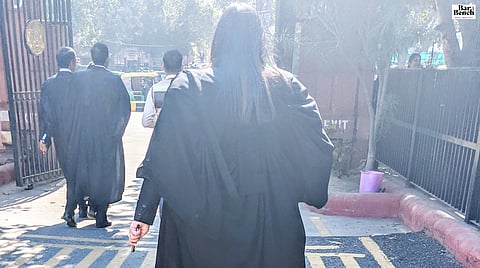
- Latest Legal News
- News
- Dealstreet
- Viewpoint
- Columns
- Interviews
- Law School
- Legal Jobs
- हिंदी
- ಕನ್ನಡ

Recently, while at the Delhi High Court, I overheard a young lawyer remark, “This coat and heat will be the death of me.”
At first, this comment might seem like it came from someone privileged, especially compared to the daily wage workers and policemen enduring the same sweltering conditions. However, the truth is that this summer has been unbearable, and our attire has exacerbated the discomfort.
The legal profession in India is steeped in tradition and I, for one, take great pride in our distinctive attire. I love our dress code - the band, the coat, the gown, the black and white dress. Some might even call it "cool," but I’d say it’s deathly hot at 47 degrees.
Those of us practicing at the Delhi High Court may be fortunate to work in a modern, air-conditioned building, but we should spare a thought for those practicing in less privileged conditions. Even the lawyers at the Supreme Court of India are not exempt, having to navigate between courts through open, often unshaded corridors.
As temperatures in cities like Delhi soar to unprecedented levels, and likely to continue as climate change unleashes its fury, I must question the practicality of the black coat in the summer. While it serves as a symbol of professionalism and formality before the court, I wonder if that purpose can be equally served by the gown instead. Climate change is an undeniable reality, and the increasing temperatures in Indian cities necessitate a re-evaluation of traditional attire.
I confess that opinions on this matter were divided among those I spoke with. I also acknowledge that the data is anecdotal at best.
But for what it’s worth, some lawyers remain staunchly against the idea of dispensing with the coat, viewing it as an integral part of the legal attire that commands respect and upholds tradition. They argue that wearing a gown without a coat could be seen as informal and inappropriate for the solemn environment of a courtroom.
Others felt that the black coat absorbs heat, making it unbearable for lawyers who have to move between different courtrooms and buildings. They argue that the primary purpose of legal attire is to maintain decorum and uniformity, which can be achieved with a gown as effectively as with a coat. The gown, they contend, offers a dignified appearance while being more practical in the Indian climate, since it is airy and doesn’t cling to the body.
The one thing that emerged from the conversations was that the debate is more than a matter of tradition versus comfort. Perhaps the discourse needs to take into account the changing environmental conditions. While respecting the solemnity and decorum of the legal profession, it is essential to consider practical adaptations that enhance the comfort and efficiency of legal practitioners.
While I was writing this piece, a petition had been moved in the Supreme Court to dispense with the black coat. I wondered if we could instead have a middle ground that has been proposed with the optionality of choosing between the coat and gown. Those more comfortable with the coat could continue.
Perhaps the Bar Council of India can gauge the general consensus and consider implementing a flexible dress code. This could involve allowing lawyers the choice between wearing a coat or a gown, depending on their comfort and the weather conditions. A flexible dress code that allows for seasonal adjustments, such as the option to wear a gown or a coat, could strike the right balance.
Payal Chawla is the founder of Juscontractus.